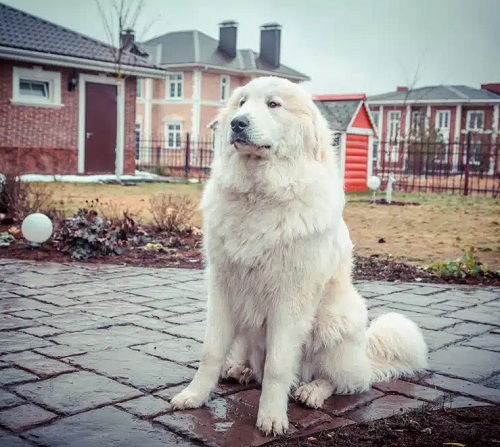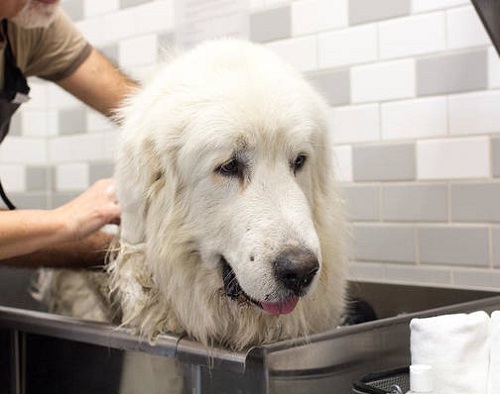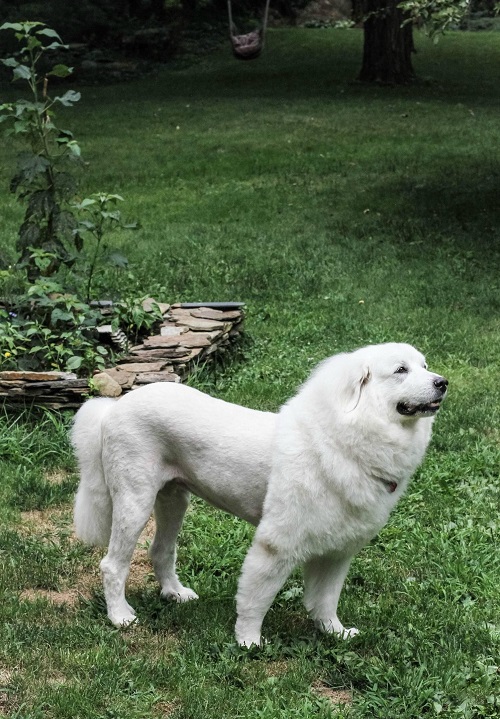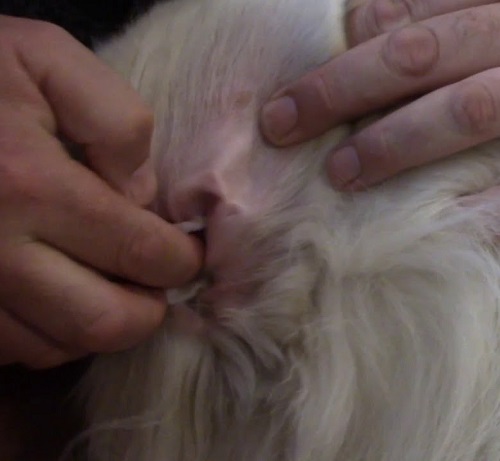Follow this comprehensive Great Pyrenees Grooming Guide for maintaining the regal coat and well-being of your pet!
The Great Pyrenees, an awe-inspiring breed, is deeply admired for its lush double coat that gives it an unmatched elegance. If you are a proud owner of the handsome breed, this Great Pyrenees Grooming Guide will provide you with all the expert tips you need to maintain its magnificent appearance.
What Do You Mean By Great Pyrenees Grooming?

Great Pyrenees grooming refers to the process of cleaning, maintaining, and enhancing the appearance of a Great Pyrenees dog’s coat and overall physical condition. Due to their thick double coat, this breed requires a unique grooming regimen that involves various tasks such as brushing, bathing, nail trimming, ear cleaning, and maintaining proper hygiene.
Grooming is essential to promote a healthy coat, prevent matting, remove loose hair, and keep the skin clean and free from debris. It also allows for early detection of any skin issues or health concerns.
Do Great Pyrenees Need to be Groomed? Why is it Necessary?
Yes, Great Pyrenees do need to be groomed. Given their distinctive double coat, regular grooming is vital for this breed to maintain a healthy, clean appearance. Here’s why regular grooming is necessary for Great Pyrenees:
- Coat Maintenance: Great Pyrenees have a thick double coat that requires regular grooming to prevent matting and tangling. Brushing removes loose hair, debris, and prevents the formation of mats, which can be uncomfortable and even painful for the dog.
- Skin Health: Regular grooming helps maintain healthy and clean skin. It allows for the early detection of skin issues such as infections, irritations, or parasites, which can be promptly addressed. Grooming also promotes proper air circulation to the skin, reducing the risk of hot spots or dermatological problems.
- Shedding Control: Great Pyrenees are known to shed heavily, especially during seasonal changes. Proper grooming helps manage excessive shedding by removing loose hair, thus reducing the amount of dog hair around your home.
- Comfort and Hygiene: Bathing your Great Pyrenees helps keep their coat clean and free from dirt, odors, and potential allergens. Regular nail trimming prevents overgrowth, discomfort, and potential paw pad injuries. Ear cleaning prevents infections, and dental hygiene helps maintain healthy teeth and gums, preventing oral issues and bad breath.
- Bonding and Well-being: Grooming sessions provide an opportunity for bonding between you and your Great Pyrenees. It allows you to spend quality time together, providing physical contact and positive reinforcement.
Learn How to Treat Collar Sores on Dogs here
Best Great Pyrenees Grooming Tools
Using the right grooming tools is crucial when caring for a Great Pyrenees. Correct tools ensure the efficient and safe removal of loose hair and mats, thus promoting a healthier and more comfortable coat. Additionally, they provide a gentle grooming experience, reducing the risk of skin irritation or injury. Some of the Best Great Pyrenees Grooming Tools include:
- Slicker brush
- Wide-toothed comb
- Dog-specific shampoo
- Towels
- Dog hairdryer (optional)
- Dog nail clippers
- Dog-specific ear cleaner
- Cotton balls
How to Groom a Great Pyrenees at Home?

- Brushing: Begin by thoroughly brushing your Great Pyrenees’s coat to remove any loose hair and tangles. Use a slicker brush or a combination of a slicker brush and a wide-toothed comb for best results. Focus on one section at a time, working from the skin outward, and be gentle to avoid discomfort or skin irritation.
- Bathing: Great Pyrenees dogs do not require frequent bathing, as their natural oils help maintain a healthy coat. However, occasional baths are necessary when they become dirty or start to develop an odor. Use a dog-specific shampoo and thoroughly rinse the coat to prevent any residue.
- Drying: After bathing, gently towel-dry your Great Pyrenees, ensuring you remove excess moisture from the coat. You can also use a hairdryer on a low heat setting to speed up the drying process, but be cautious and keep it at a safe distance to prevent overheating.
- Nail Trimming: Regular nail trimming is essential for your Great Pyrenees’s comfort and mobility. Use a pair of dog nail clippers to carefully trim the tips of the nails, avoiding the quick (the pink area containing blood vessels). The frequency of nail trimming for a Great Pyrenees depends on their activity level and lifestyle. Generally, nails should be trimmed every 4-6 weeks to maintain a proper length.
- Paw Pad Care: Check your Great Pyrenees’s paw pads regularly for any signs of injury, cracking, or dryness. Apply a dog-specific paw balm or moisturizer to keep the pads soft and protected. Trim the hair between the paw pads to prevent matting and the accumulation of debris.
- Ear Cleaning: Cleaning your Great Pyrenees’s ears is an important part of grooming. Use a dog-specific ear cleaner recommended by your veterinarian. Moisten a cotton ball or pad with the cleaner and gently wipe the outer part of the ear, avoiding the ear canal. Do not insert anything deep into the ear canal, as it can cause injury. If you notice any signs of infection, such as redness, swelling, or an unusual odor, consult your veterinarian for further guidance.
- Dental Hygiene: Oral health is an important aspect of overall grooming. Brush your Great Pyrenees’s teeth regularly using a dog-specific toothbrush and toothpaste. This helps prevent dental issues and keeps their breath fresh.
Great Pyrenees Grooming Styles

Great Pyrenees are often kept in their natural state, as their double coat is a crucial part of their breed characteristics and provides insulation against both cold and heat. However, there are a few common grooming styles:
- Lion Cut: The Lion Cut is a popular grooming style for Great Pyrenees, where the fur is trimmed shorter around the body while leaving the mane, tail, and leg hair longer. This style gives the dog a regal appearance.
- Puppy Cut: The Puppy Cut involves trimming the entire coat to a uniform length, typically around 1-2 inches, giving the Great Pyrenees a youthful and adorable look. It requires less maintenance than other styles.
Some Tips for Enhancing Grooming
- Nutrition: A balanced diet rich in essential fatty acids promotes a healthy coat and skin.
- Regular Exercise: Regular exercise promotes blood circulation, which benefits the skin and coat. Engage your Great Pyrenees in daily physical activities to maintain their overall well-being.
- Preventative Measures: Regularly use flea and tick prevention products recommended by your veterinarian to protect your Great Pyrenees from infestations.
- Skin and Coat Supplements: Certain supplements, such as omega-3 fatty acids, can improve the health of your Great Pyrenees’s skin and coat.
- Mindful Mat Removal: If you come across mats or tangles in your Great Pyrenees’s coat, take care when removing them. Use a detangling spray or a slicker brush to gently work through the mats, starting from the outer edges and working your way inward. Avoid pulling or tugging, as it can cause discomfort or even skin irritation.
- Environmental Considerations: Great Pyrenees dogs are known to be outdoor enthusiasts, but their coat can attract dirt, debris, and allergens. Be mindful of the environment they are in and take steps to keep their coat clean. Wipe their paws after walks, avoid muddy areas, and provide a clean resting space to prevent their coat from getting excessively dirty.
- Regular Health Check-ups: Alongside grooming, ensure regular veterinary check-ups for your Great Pyrenees. The veterinarian can assess the overall health of your dog, provide specific grooming recommendations, and address any skin or coat issues that require attention.
Best Grooming Techniques for Preventing Matting in a Great Pyrenees’s Fur
To prevent matting in a Great Pyrenees’s fur, it’s important to use proper grooming techniques. Start by using a slicker brush or combine it with a wide-toothed comb. Brush the coat in sections, working from the skin outward, and be gentle to avoid discomfort. Focus on areas prone to matting, such as behind the ears, under the armpits, and around the tail.
How Often Should a Great Pyrenees be Groomed?

The frequency of grooming a Great Pyrenees can depend on several factors, such as the dog’s activity level, health, and the current season. As a general rule, you may perform a thorough brushing once a week to keep their thick, double-coat free from mats and tangles.
However, during shedding seasons, typically spring and fall, daily brushing may be needed to manage the extra loose hair. Bath your pet only when, roughly every 3-4 months, or when your Great Pyrenees gets particularly dirty to prevent stripping their coat of natural oils. Always remember regular grooming not only keeps your dog looking its best but also allows for early detection of potential health issues.
Inspection of Skin and Coat for Potential Issues
When inspecting your Great Pyrenees’s skin and coat, look out for any signs of redness, inflammation, rashes, sores, or excessive itching. Pay attention to areas where the skin is exposed or has less hair coverage. Check for fleas, ticks, or other parasites and any changes in the thickness or texture of the coat, as well as any unusual odors.
Feel for any lumps, bumps, or unusual growths on the skin that wasn’t present before. If your Great Pyrenees has been scratching a specific area excessively, it may indicate an issue. If you notice anything concerning, consult your veterinarian for further evaluation and guidance.
Find some Homemade Treats for Dogs with Sensitive Stomach here
Quick Takeaways
Grooming is a necessary aspect of caring for a Great Pyrenees dog. Regular grooming helps maintain a healthy coat, prevents matting, removes loose hair, and keeps the skin clean and free from debris. It also allows for the early detection of any skin issues or health concerns. Grooming not only contributes to the dog’s physical well-being but also helps them look their best, showcasing their natural beauty and regal appearance.
FAQs
1. Are Great Pyrenees Easy to Groom?
Great Pyrenees dogs have a dense double coat that requires regular grooming, and while they are generally cooperative during grooming sessions, they do require consistent care. It requires time, patience, and sometimes a bit of strength to thoroughly groom them, especially if they aren’t fond of grooming practices.
2. How Do You Wash and Brush a Great Pyrenees?
To wash a Great Pyrenees, start by thoroughly wetting their coat with warm water. Use a dog-specific shampoo and work it into a lather, ensuring it reaches the skin. Gently massage the shampoo through the coat, paying attention to any soiled or odorous areas. Rinse the coat thoroughly, making sure to remove all shampoo residue. Afterward, towel-dry the coat, or you can use a hairdryer on a low heat setting, maintaining a safe distance to prevent overheating.
When brushing a Great Pyrenees, use a slicker brush or a combination of a slicker brush and a wide-toothed comb. Begin at the roots and brush outwards in the direction of hair growth, working in sections. Focus on removing loose hair and preventing matting. Pay extra attention to areas prone to tangling, such as behind the ears, under the armpits, and around the tail. Be gentle to avoid discomfort or skin irritation, and always use positive reinforcement to make the grooming experience more pleasant for your Great Pyrenees.
3. How Do I keep My Great Pyrenees Cool?
Great Pyrenees have a thick double coat that provides insulation, which can make them susceptible to overheating in hot weather. To keep them cool:
- Provide access to shade and cool areas indoors.
- Ensure they have access to fresh water at all times.
- Avoid strenuous exercise during the hottest parts of the day.
- Consider using cooling mats or beds to provide relief from the heat.
- Trim the hair around their paw pads to prevent heat retention.
- Use cooling vests or bandanas designed for dogs during outdoor activities.
- Never leave your Great Pyrenees in a parked car, as temperatures can rise dangerously fast.
- Monitor your Great Pyrenees for signs of overheating, such as excessive panting, drooling, weakness, or disorientation. If you suspect heatstroke, seek immediate veterinary attention.
Remember, each dog’s tolerance to heat may vary, so it’s important to observe your Great Pyrenees and adjust their environment accordingly to keep them comfortable and safe.
